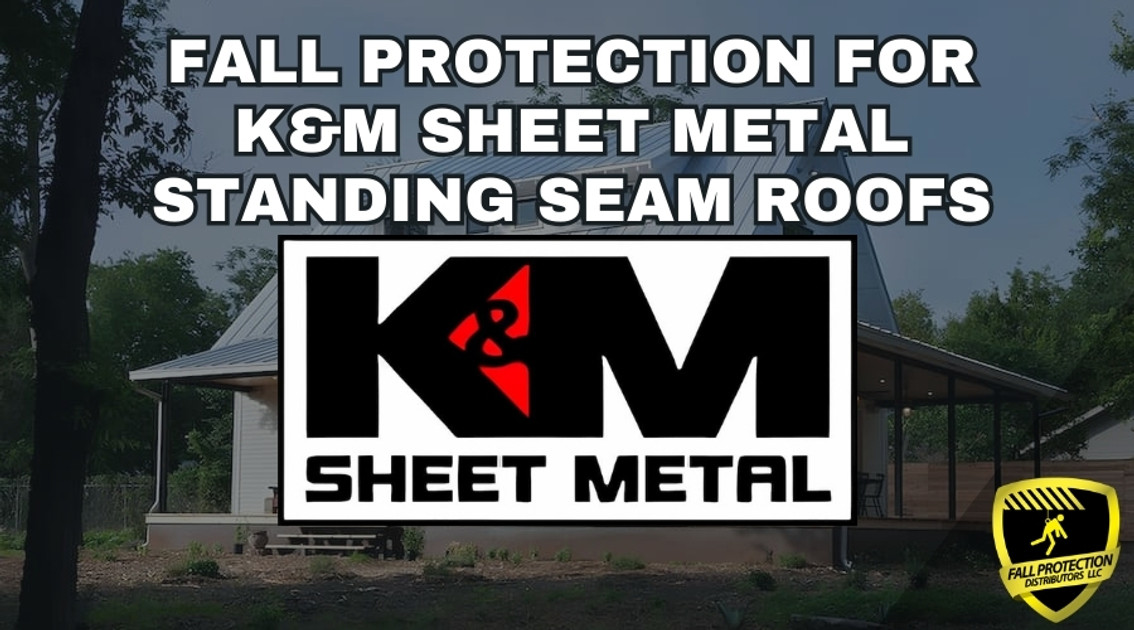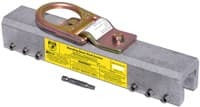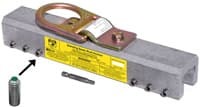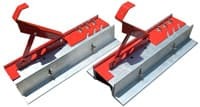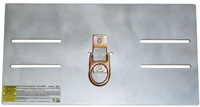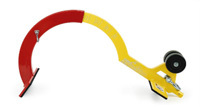Fall Protection Strategies For K&M Standing Seam Roofs
Posted by Howie Scarboro - CEO Fall Protection Distributors, LLC on Dec 27th 2024
See the Roof Anchor Compatibility Chart for K&M Sheet Metal Standing Seam Panels.

Who Is K&M Sheet Metal?
Based in Durham, NC, K&M Sheet Metal has earned a stellar reputation for delivering custom architectural metal products and standing seam roofing systems to clients across the United States. K&M combines traditional craftsmanship with cutting-edge technology to create bespoke metal solutions. Their ability to fabricate nearly any sheet metal product, from finials and dormers to complex roofing panels, sets them apart.
What makes K&M exceptional? They're redefining the sheet metal industry, not by changing the material itself but by transforming the quality of products and the customer experience. Equipped with advanced tools like brakes, shears, laser cutters, and roll formers, their facility can tackle everything from standard roofing panels to custom cutting and bending. K&M works with an impressive array of materials, including copper, zinc, aluminum, steel, and stainless steel, and provides flexible sizing options, producing panels up to 27 inches wide and 40 feet long.
As a women-owned business and an equal opportunity employer, K&M values its team as the backbone of the operation, with dedicated sales, manufacturing, and customer service departments. The company's client-first approach and focus on affordability ensure that every project—no matter how intricate—is completed with precision and care. Whether you need standing seam panels, decorative accents, or gutter systems, K&M Sheet Metal is committed to delivering excellence and building lasting relationships.

Why Are Compatible Fall Protection Anchors Critical For Standing Seam Panels?
Standing seam metal roofs offer sleek aesthetics, impressive durability, and watertight performance, making them popular for residential and commercial applications. However, their unique design—featuring raised, concealed seams without exposed fasteners—poses specific challenges for fall protection during installation and maintenance. Using the wrong anchor system on a standing seam roof can compromise worker safety and damage the roof.
Traditional fall protection systems that rely on drilling or penetrating the roof surface are a big no-go for standing seam panels. Drilling into the seams destroys the roof's watertight integrity, leading to leaks, premature corrosion, and costly repairs. Additionally, penetrating the panels can void warranties, negating the roof system's long-term benefits.
Systems like the Standing Seam Roof Anchor (SSRA1) clamp securely onto the raised seams without requiring drilling or modifications. These anchors preserve the structural and aesthetic integrity of the roof while providing OSHA-compliant tie-off points for workers. Paired with SSRA2 Adjustable Roof Jacks, walkboards can create stable, elevated pathways across the roof, enhancing safety and mobility without risking damage. SSRA3 Anchor Plates can be combined with temporary 100-foot horizontal lifeline systems for larger projects, allowing multiple workers to move securely across the roof surface.
For substrates that aren't compatible with SSRA products—such as aluminum panels or lighter gauge materials—the Ridge Pro Steep Assist Anchor offers an excellent alternative. This system hooks over the ridge of 6/12 to 12/12 pitch roofs, ensuring workers maintain 100% tie-off at all times.
In short, selecting the proper fall protection anchors for standing seam roofs is more than compliance—it's about preserving the integrity of the panels, protecting warranties, and safeguarding the workers who bring these roofing systems to life. With the right approach, you can achieve safety and performance without compromise.
Mechanical Lock Panels

K&M Sheet Metal's Mechanical Lock Panels provide a reliable and versatile standing seam solution for residential and commercial projects. These panels feature a concealed fastener and clip system, ensuring a clean, sleek appearance while enhancing the roof's watertight integrity. See the Roof Anchor Compatibility Chart for K&M Sheet Metal Mechanical Lock Standing Seam Panels.
The panels are available in two seam height options: 1-inch and 1.5-inch, with corresponding finished coverages of 17 and 16 inches respectively. While the standard panel length starts at 3 feet, shipping orders max out at 20 feet for convenience. If picking up directly from K&M's Durham, NC facility, panel lengths up to 40 feet are available, providing additional flexibility for large-scale projects.
Substrate options include premium materials like 16 oz and 20 oz copper, 24-gauge Galvalume Plus, 24-gauge 304 stainless steel, and aluminum. These options ensure durability and design versatility to meet a wide range of architectural needs, making Mechanical Lock panels an ideal choice for both performance and aesthetic applications.
Fall Protection for Mechanical Lock Panels
Ensuring proper fall protection when working with Mechanical Lock Panels is essential for worker safety and roof longevity. For 22—and 24-gauge steel panels, the SSRA1 Seam Anchor system is the best choice. This innovative, non-penetrating anchor clamps securely to the standing seam without drilling, preserving the panel's watertight integrity and ensuring OSHA-compliant safety. The SSRA1 anchor is a dependable worker tie-off point during installation or maintenance.
When paired with the SSRA2 Adjustable Roof Jack, workers can install walkboards across the roof without any penetrations. The adjustable height feature accommodates the Mechanical Lock panels' 1-inch or 1.5-inch seam heights, creating a stable and secure platform for navigating the roof safely. For larger projects requiring continuous mobility, the SSRA3 Anchor Plates combined with a temporary horizontal lifeline system, such as the Malta Dynamics HLL3001, allow up to two workers to remain securely tied off while covering more ground efficiently.
For copper, aluminum, and stainless steel panels—or any substrates other than 22—and 24-gauge steel—the Ridge Pro Steep Assist Anchor provides an excellent alternative. This non-penetrating system hooks securely over the roof ridge. It maintains a stable tie-off point on steep slopes ranging from 6/12 to 12/12 pitches. The Ridge Pro ensures that workers remain 100% tied off, even on challenging roof surfaces, without compromising the roof's design or material integrity.
Curved Mechanical Lock Panels introduce additional safety complexities. Standard SSRA and Ridge Pro products are incompatible with curved applications, so conducting a site-specific safety inspection is essential. A trained safety professional can develop a tailored fall protection plan to ensure workers remain secure while accommodating the unique design of curved panels.
By selecting fall protection systems suited explicitly to Mechanical Lock Panels, contractors can prioritize safety, maintain OSHA compliance, and preserve the roofing system's performance and visual appeal. With the right tools and strategies, workers can tackle any project with confidence and security.
Snap Lock Panels

K&M Sheet Metal's Snap Lock Panels are a versatile and widely used standing seam roofing option, prized for their clean appearance and ease of installation. Sold by the lineal foot with a minimum order of 100 feet, these panels offer flexibility to meet project-specific requirements. Panel lengths range from a minimum of 3 feet to 20 feet for shipping, making them ideal for residential and commercial applications. See the Roof Anchor Compatibility Chart for K&M Sheet Metal Snap Lock Standing Seam Panels.
The Snap Lock profile comes with seam heights of 1 inch or 1.5 inches, providing design flexibility without sacrificing performance. These panels feature a concealed fastener and clip system, ensuring a secure attachment to the roof deck while maintaining a sleek, modern look. Finished coverage is 17 inches for the 1-inch seam and 16 inches for the 1.5-inch seam, with custom sizes and tapered panel options available upon request.
Material options include 16 oz and 20 oz copper and aluminum. 24-gauge Galvalume Plus and 304 stainless steel are more durable options. However, due to salt exposure, Kynar steel systems are not recommended for coastal installations.
Fall Protection for Snap Lock Panels
Implementing proper fall protection for Snap Lock Panels is crucial for ensuring worker safety during installation and maintenance. For 22- and 24-gauge steel panels, the SSRA1 Seam Anchor system is a reliable, non-penetrating solution. By securely clamping onto the standing seam without drilling, the SSRA1 preserves the panel's watertight integrity while providing workers with a safe, OSHA-compliant tie-off point.
Combined with the SSRA2 Adjustable Roof Jack, the setup supports 10-foot walkboards to create a stable working platform. The SSRA2's adjustable height feature seamlessly accommodates Snap Lock's 1-inch and 1.5-inch seam heights, allowing workers to move across the roof efficiently. For larger projects requiring greater mobility, the SSRA3 Anchor Plates, used alongside the Malta Dynamics HLL3001 Horizontal Lifeline System, enable up to two workers to remain securely tied off while navigating extensive roof areas.
For copper, aluminum, and stainless steel Snap Lock panels—or any substrates other than 22- and 24-gauge steel—the Ridge Pro Steep Assist Anchor is the optimal solution for steep slopes ranging from 6/12 to 12/12 pitches. This anchor hooks securely over the roof peak, ensuring workers maintain 100% tie-off at all times. Its lightweight and user-friendly design makes it a dependable choice for non-steel Snap Lock systems.
It's important to note that curved Snap Lock panels introduce additional challenges for fall protection. Standard SSRA and Ridge Pro systems are not typically compatible with curved applications. To ensure worker safety without compromising the roof design, a trained safety professional should conduct a site-specific inspection to develop a tailored fall protection strategy.
By using fall protection systems intended for Snap Lock Panels, contractors can ensure OSHA compliance, worker safety, and the long-term integrity of the roof. Whether tackling straight or steep installations, these solutions allow projects to move forward efficiently without sacrificing performance or safety.
Nail Strip Lock Panels

K&M Sheet Metal's Nail Strip Lock Panels offer a practical and cost-effective standing seam solution, combining ease of installation with a sleek, modern look. These panels have a nail strip flange that eliminates the need for clips, making the system economical and quick to install. Like Snap Lock panels, the Nail Strip Lock system relies on the material's rigidity for durability and performance. See the Roof Anchor Compatibility Chart for K&M Sheet Metal Nail Strip Lock Standing Seam Panels.
Available in 1-inch and 1.5-inch seam heights, this panel system is ideal for shorter roof runs where expansion and contraction are minimal concerns. The minimum roof pitch for the 1-inch seam height is 3:12. In contrast, the 1.5-inch seam height is suitable for roof pitches as low as 1.5:12, ensuring flexibility for various architectural needs.
These panels snap together effortlessly, making them an excellent choice for residential and light commercial projects prioritizing efficiency and affordability. The concealed fastener design ensures a clean finish, while the robust construction maintains structural integrity over time.
Fall Protection for Nail Strip Lock Panels
Safety during the installation and maintenance of Nail Strip Lock Panels requires fall protection systems compatible with standing seam roofs. For 22—and 24-gauge steel panels, the SSRA1 Seam Anchor system is the optimal choice. This non-penetrating anchor clamps securely onto the seam without compromising the roof's watertight integrity, providing OSHA-compliant safety for workers.
The SSRA2 Adjustable Roof Jack enhances this setup by supporting 10-foot walkboards. This assembly creates a stable work platform across the roof, accommodating the panel's 1-inch or 1.5-inch seam heights without risking roof damage. For more extensive projects, the SSRA3 Anchor Plates paired with a 100-foot horizontal lifeline system, such as the Malta Dynamics HLL3001, allow up to two workers to move safely and efficiently across the roof while maintaining secure tie-offs.
For substrates such as aluminum or stainless steel, or when the seams are incompatible with SSRA products (which can sometimes occur with snap-together systems), the Ridge Pro Steep Assist Anchor is the preferred solution. This system hooks securely over the roof ridge, providing a stable tie-off point for slopes ranging from 6/12 to 12/12. The Ridge Pro ensures workers remain 100% tied off, even on steep or challenging roof surfaces, without requiring penetrations or modifications to the roof.
Whether tackling shorter runs or large-scale projects, combining Nail Strip Lock Panels and tailored fall protection systems ensures that safety, performance, and aesthetics remain uncompromised.
Standing U Seam Panels

K&M Sheet Metal's Standing U Seam Panels are available in 1-inch and 1.5-inch seam heights, offering flexibility for various roofing projects. These panels can be used with heavy-duty batten cleats to create Batten Lock Panels. Workers mount the panels to the roof and install a separate batten cap over the seams. See the Roof Anchor Compatibility Chart for K&M Sheet MetalStanding U Seam Standing Seam Panels.
One of the standout features of Standing U Seam Panels is the ability to remove damaged panels individually, simplifying repairs and maintenance without disturbing the rest of the roof. The 1-inch seam height requires a minimum roof pitch of 3:12. In contrast, the 1.5-inch seam height accommodates pitches as low as 1.5:12, ensuring compatibility with various architectural styles and applications.
These panels are ideal for both residential and commercial roofing projects. They offer a durable, aesthetically pleasing solution with practical repair capabilities.
Fall Protection for Standing U-Seam Panels
When working on Standing U Seam Panels, seam-mounted fall protection anchors are incompatible with the batten strip design. Instead, the Ridge Pro Steep Assist Anchor is the preferred fall protection solution.
The Ridge Pro hooks securely over the roof peak, providing a stable tie-off point for slopes ranging from 6/12 to 12/12. Its non-penetrating design ensures the roof's structural integrity remains intact while maintaining OSHA-compliant safety standards.
By incorporating the Ridge Pro Steep Assist, contractors and workers can ensure a safe working environment without compromising the design or functionality of Standing U Seam Panels. This tailored approach to fall protection prioritizes safety and performance, allowing projects to move forward efficiently and securely.
Standing Seam Metal Roof Anchor Panel Compatibility Chart For K&M Sheet Metal
| Mechanical Lock Panels 22-24 ga. |
Snap Lock Panels 22-24 ga. |
Nail Strip Lock Panels 22-24 ga. |
Standing U Seam Panels Batten Strip |
|
|---|---|---|---|---|
| YES | YES | YES | NO | |
| YES | YES | YES | NO | |
| YES | YES | YES | NO | |
| YES | YES | YES | NO | |
| YES | YES | YES | YES |
Contact Us For More Information
For further details on roofing solutions and fall protection systems, contact us at 863-703-4522 or www.StandingSeamRoofAnchor.com. Let's work together to make your roofing projects safe, beautiful, and built to last. For more safety tips, check out OSHA's 48-page fall protection manual. Once you have determined the most suitable anchors for your roof system, download our free Anchor Inspection Form.
Safety Tips For Standing Seam Roofs
Equip Workers with High-Quality Safety Gear
Proper safety gear isn't just a box to check—it's a worker's first line of defense. Providing OSHA-compliant, well-fitted harnesses, lanyards, and fall arrest systems ensures maximum protection while boosting worker comfort and confidence. When gear fits appropriately and performs reliably, workers are more likely to use it consistently, minimizing accidents and injuries.
Use Specialized Anchor Systems for Standing Seam Roofs
Standing seam roofs require precision in fall protection. Non-penetrating, clamp-on anchors are the gold standard because they attach securely to seams without drilling, preserving the roof's watertight design. Avoid systems that rely on hidden clips, as locating these under finished panels can be time-consuming and inefficient, delaying progress and increasing risks.
Promote a Culture of Safety
Safety is everyone's responsibility, but it starts with leadership. Foster a work environment where safety is prioritized through open communication about risks, regular training sessions, and team accountability. When workers feel empowered to identify hazards and practice safe habits, accidents become rare, and projects run more smoothly.
Set Up Protective Barriers for Work Zones
Work zones need clearly defined boundaries, especially on large or low-slope roofs. Installing guardrails and warning lines keeps workers aware of their proximity to roof edges and reduces the risk of falls. With these barriers, crews can focus on their tasks without compromising safety.
Ensure Proper Footwear for Stability
Metal roofs can quickly become hazardous in wet, icy, or steep conditions. Outfitting workers with high-quality, non-slip footwear is a simple yet highly effective measure. Durable shoes designed for roofing applications improve traction and stability, reducing the chance of slips or falls.
Develop OSHA-Compliant Safety Plans
A detailed, OSHA-compliant safety plan provides the foundation for a secure job site. Address every aspect of fall protection, from emergency response procedures to proper equipment use and rescue protocols. A solid plan keeps workers safe and ensures compliance with industry standards.
Ensure Stable Access Points
Safe access to the roof is just as important as safety while on the roof. Ladders should always be set on level ground and positioned according to the 4-to-1 rule—one foot of base distance for every four feet of height. Secure placement minimizes ladder slips, ensuring smooth and reliable access for workers.
Install Permanent Roof Anchor Systems
Permanent roof anchors offer a reliable and long-term solution for roofs requiring regular maintenance. These fixed tie-off points simplify safety setup and provide peace of mind, particularly for commercial and industrial properties with ongoing access needs.
Encourage the Use of Trauma Straps
Trauma straps are a life-saving addition to fall protection systems. In the event of a fall, they relieve pressure on the legs during suspension, helping maintain circulation until rescue. Regular training ensures workers know how to deploy them quickly and effectively in an emergency.
Consult Experts for Curved Metal Panels
Curved metal panels present unique challenges that standard safety solutions can't always address. Relying on fall protection experts ensures that customized systems are compatible with these complex roof profiles. This approach protects workers and preserves the roof's integrity, keeping safety and performance in perfect balance.
Disclaimer
The views, recommendations, and information presented in this blog are solely those of the author and do not necessarily reflect the opinions or positions of the featured panel manufacturer, its brands, subsidiaries, or parent companies. Customers are strongly encouraged to reach out directly to the roof panel manufacturer for inquiries regarding fall protection compatibility with their products and to address any potential warranty issues that may arise following the installation of our products.

